A High-Performance, Low-Cost, and Integrated Hairpin Topology RF Switched Filter Bank for Radar Applications
Abstract
1. Introduction
2. Design and Simulation
Hairpin Filter Design and Fabrication
3. Implementation and Results
4. Conclusions
Author Contributions
Funding
Institutional Review Board Statement
Informed Consent Statement
Data Availability Statement
Acknowledgments
Conflicts of Interest
References
- Paduan, J.D.; Washburn, L. High-frequency radar observations of ocean surface currents. Annu. Rev. Mar. Sci. 2013, 5, 115–136. [Google Scholar] [CrossRef] [PubMed]
- Zohuri, B. Fundaments of Radar. In Radar Energy Warfare and the Challenges of Stealth Technology; Springer: Cham, Switzerland, 2020; pp. 1–110. [Google Scholar]
- Barbarossa, S.; Farina, A. Space-time-frequency processing of synthetic aperture radar signals. IEEE Trans. Aerosp. Electron. Syst. 1994, 30, 341–358. [Google Scholar] [CrossRef]
- Karthikeyan, S.; Kshetrimayum, R.S. Harmonic suppression of parallel coupled microstrip line bandpass filter using CSRR. Prog. Electromagn. Res. Lett. 2009, 7, 193–201. [Google Scholar] [CrossRef]
- Kim, B.S.; Lee, J.W.; Song, M.S. An implementation of harmonic-suppression microstrip filters with periodic grooves. IEEE Microw. Wirel. Components Lett. 2004, 14, 413–415. [Google Scholar] [CrossRef]
- Myoung, S.S.; Yook, J.G. Miniaturisation and harmonic suppression method of parallel coupled-line filters using lumped capacitors and grounding. Electron. Lett. 2005, 41, 1. [Google Scholar] [CrossRef]
- Ramzan, F.; Rafique, A.; Khan, D.; Hassan, N.U.; Naqvi, I.H.; Mehmood, M.Q.; Zubair, M.; Massoud, Y. Reconfigurable intelligent surfaces: Field trial campaign for performance evaluation from near-to far-field regions. In Proceedings of the 2023 IEEE International Symposium on Circuits and Systems (ISCAS), Monterey, CA, USA, 21–25 May 2023; pp. 1–4. [Google Scholar]
- Hong, J.S.G.; Lancaster, M.J. Microstrip Filters for RF/Microwave Applications; John Wiley & Sons: Hoboken, NJ, USA, 2004. [Google Scholar]
- Alvi, T.S.; Ali, M.; Mehmood, Z.; Mehmood, M.Q. A Novel Ultra-wideband Fractal Antenna with Defected Ground Structure for W-band Applications. In Proceedings of the 2023 IEEE International Conference on Energy, Power, Environment, Control, and Computing (ICEPECC), Gujrat, Pakistan, 8–9 March 2023; pp. 1–4. [Google Scholar]
- Liu, L.Q.; Lai, H.S.; Hu, H.M.; Chen, J.J.; Weng, M.H.; Yang, R.Y. A simple method to design a UWB filter with a notched band using short-circuit step impedance stubs. Electronics 2022, 11, 1124. [Google Scholar] [CrossRef]
- Najafi, M.; Hazeri, A.R. Microstrip dual-narrowband bandpass filter with independent passbands. Wirel. Pers. Commun. 2021, 119, 3503–3516. [Google Scholar] [CrossRef]
- Amirian, M.; Karimi, G.; Wiltshire, B.D.; Zarifi, M.H. Differential narrow bandpass microstrip filter design for material and liquid purity interrogation. IEEE Sens. J. 2019, 19, 10545–10553. [Google Scholar] [CrossRef]
- Palanisamy, S.; Thangaraju, B.; Khalaf, O.I.; Alotaibi, Y.; Alghamdi, S. Design and synthesis of multi-mode bandpass filter for wireless applications. Electronics 2021, 10, 2853. [Google Scholar] [CrossRef]
- Akujuobi, C.M.; Sadiku, M.N. Introduction to Broadband Communication Systems; Chapman and Hall/CRC Press: New York, NY, USA, 2007. [Google Scholar] [CrossRef]
- Wang, Z.; Shu, Y.; Ma, S.; Guo, X.; Yang, W.; Ding, X.; Lyu, X.; Yu, F. 3D Heterogenous Integrated Wideband Switchable Bandpass Filter Bank for Millimeter Wave Applications. Electronics 2022, 12, 194. [Google Scholar] [CrossRef]
- Du, T.; Guan, B.; Zhang, P.; Gu, Y.; Wei, D. An intrinsically switched tunable CABW/CFBW bandpass filter. Electronics 2021, 10, 1318. [Google Scholar] [CrossRef]
- Ahmed, S.; Kim Geok, T.; Alias, M.Y.; Hossain, F.; Alsariera, H.; Abdaziz, A.; Soh, P.J. A UWB antenna array integrated with multimode resonator bandpass filter. Electronics 2021, 10, 607. [Google Scholar] [CrossRef]
- Shannon, C.E. A Mathematical Theory of Communication. Bell Syst. Tech. J. 1948, 27, 379–423. [Google Scholar] [CrossRef]
- Makwana, N.D.; Singh, V.; Ghadiya, A.; Dhar, J. Design and Development of a Narrow Band Dielectric Resonator Filter at Ku Band. In Proceedings of the 2018 IEEE MTT-S International Microwave and RF Conference (IMaRC), Kolkata, India, 28–30 November 2018. [Google Scholar]
- Wang, L.; You, C.; Ge, C.; Zhu, X. Narrow-Band Bandpass Filter with Enhanced Q and Selectivity Based on Coupled Negative Resistance. In Proceedings of the 2012 4th International High Speed Intelligent Communication Forum, Nanjing, China, 10–11 May 2012; pp. 1–3. [Google Scholar] [CrossRef]
- Pusuluri, V.B.; Mannam, V.; Ponnapalli, V.A.S.; Prasad, A.M. Narrowband Hairpin Bandpass Filter for 4G LTE Applications. In Proceedings of the 2021 IEEE International IOT, Electronics and Mechatronics Conference (IEMTRONICS), Toronto, ON, Canada, 21–24 April 2021. [Google Scholar]
- Liu, B.; Yang, T.; Chi, P.L. An Analysis and Design Method for Wide Range Reconfigurable Filter Bank Using Parallel Inductive Switch Network. IEEE Trans. Circuits Syst. II Express Briefs 2022, 69, 3381–3385. [Google Scholar] [CrossRef]
- Sabban, A.; Cabiri, J.; Carmeli, E. 18 to 40 GHz Integrated Compact Switched Filter Bank Module. In Proceedings of the 2007 International Symposium on Signals, Systems and Electronics, Montreal, QC, Canada, 30 July–2 August 2007; pp. 347–350. [Google Scholar] [CrossRef]
- Zahradnik, P.; Vlcek, M. Perfect Decomposition Narrow-Band FIR Filter Banks. IEEE Trans. Circuits Syst. II Express Briefs 2012, 59, 805–809. [Google Scholar] [CrossRef]
- Kang, K.M.; Park, J.C.; Park, S. Implementation of Filter Bank–Based RF Transceiver for TV White Space. ETRI J. 2015, 37, 1077–1086. [Google Scholar] [CrossRef]
- Moattari, A.M.; Bijari, A.; Razavi, S.M. A new compact, wide bandwidth dual-passband microstrip filter based on dual-mode stepped-impedance-resonators. Int. J. Microw.-Comput.-Aided Eng. 2022, 32, e23478. [Google Scholar] [CrossRef]
- Fourn, E.; Pothier, A.; Champeaux, C.; Tristant, P.; Catherinot, A.; Blondy, P.; Tanne, G.; Rius, E.; Person, C.; Huret, F. MEMS switchable interdigital coplanar filter. IEEE Trans. Microw. Theory Tech. 2003, 51, 320–324. [Google Scholar] [CrossRef]
- Blondy, P.; Pothier, A.; Fourn, E.; Champeaux, C.; Tristant, P.; Catherinot, A.; Tanne, G.; Rius, E.; Person, C.; Huret, F. Tunable Interdigital Coplanar Filters Using MEMS Capacitors. In Proceedings of the 2002 32nd European Microwave Conference, Milan, Italy, 23–26 September 2002; pp. 1–4. [Google Scholar] [CrossRef]
- Nakirekanti, M.; Hemalatha, Y. Embedded and RF switchable ultra-wide band filter bank architecture for radar applications. Int. J. Inf. Technol. 2022, 14, 3155–3163. [Google Scholar] [CrossRef]
- Brown, A.; Rebeiz, G. A varactor-tuned RF filter. IEEE Trans. Microw. Theory Tech. 2000, 48, 1157–1160. [Google Scholar] [CrossRef]
- Latip, M.A.A.; Salleh, M.K.M.; Wahab, N.A. Tuning Circuit Based on Varactor for Tunable Filter. In Proceedings of the 2011 IEEE International RF & Microwave Conference, Seremban, Malaysia, 12–14 December; 2011; pp. 26–28. [Google Scholar]
- Novgorodov, V.; Freisleben, S.; Hornsteiner, J.; Schmachtl, M.; Vorotnikov, B.; Heide, P.; Vossiek, M. Compact low-loss 2.4 GHz ISM-band SAW bandpass filter on the LTCC substrate. In Proceedings of the 2009 Asia Pacific Microwave Conference, Singapore, 7–10 December 2009. [Google Scholar] [CrossRef]
- Brito-Brito, Z.; Llamas-Garro, I.; Navarro-Muñoz, G.; Perruisseau-Carrier, J.; Pradell, L.; Giacomozzi, F.; Colpo, S. Precise frequency and bandwidth control of switchable microstrip bandpass filters using diode and microelectro-mechanical system technologies. IET Microw. Antennas Propag. 2012, 6, 713–719. [Google Scholar] [CrossRef]
- Al-Yasir, Y.I.; Parchin, N.O.; Abdulkhaleq, A.M.; Bakr, M.S.; Abd-Alhameed, R.A. A Survey of Differential-Fed Microstrip Bandpass Filters: Recent Techniques and Challenges. Sensors 2020, 20, 2356. [Google Scholar] [CrossRef] [PubMed]
- Hou, Z.; Liu, C.; Zhang, B.; Song, R.; Wu, Z.; Zhang, J.; He, D. Dual-/Tri-Wideband Bandpass Filter with High Selectivity and Adjustable Passband for 5G Mid-Band Mobile Communications. Electronics 2020, 9, 205. [Google Scholar] [CrossRef]
- Sun, J.S.; Kaneda, N.; Baeyens, Y.; Itoh, T.; Chen, Y.K. Multilayer Planar Tunable Filter With Very Wide Tuning Bandwidth. IEEE Trans. Microw. Theory Tech. 2011, 59, 2864–2871. [Google Scholar] [CrossRef]
- Chun, Y.H.; Shaman, H.; Hong, J.S. Switchable Embedded Notch Structure for UWB Bandpass Filter. IEEE Microw. Wirel. Components Lett. 2008, 18, 590–592. [Google Scholar] [CrossRef]
- Jiang, T.; Zhang, X.; You, L.; Zhang, D. Tunable Embedded Notch Structure for UWB bandpass filter. In Proceedings of the 10th International Conference on Wireless Communications, Networking and Mobile Computing (WiCOM 2014), Beijing, China, 26–28 September 2014. [Google Scholar]
- Reines, I.C.; Goldsmith, C.L.; Nordquist, C.D.; Dyck, C.W.; Kraus, G.M.; Plut, T.A.; Finnegan, P.S.; IV, F.A.; Sullivan, C.T. A low loss RF MEMS Ku-band integrated switched filter bank. IEEE Microw. Wirel. Components Lett. 2005, 15, 74–76. [Google Scholar] [CrossRef]
- Patil, M.A.; Parane, K.; Poojara, S.; Patil, A. Internet-of-things and mobile application based hybrid model for controlling energy system. Int. J. Inf. Technol. 2021, 13, 2129–2138. [Google Scholar] [CrossRef]
- Chen, C.P.; Takakura, Y.; Nihie, H.; Ma, Z.; Anada, T. Design of compact notched UWB filter using coupled external stepped-impedance resonator. In Proceedings of the APMC 2009—Asia Pacific Microwave Conference 2009, Singapore, 7–10 December 2009; pp. 945–948. [Google Scholar] [CrossRef]
- Singh, K.; Soni, B.K.; Nirmal, A.V. Wideband microstrip band stop filters realization with interdigital topologies. Int. J. Inf. Technol. 2019, 11, 479–483. [Google Scholar] [CrossRef]
- Hayati, M.; Majidifar, S.; Sobhani, S.N. Using a hybrid encoding method based on the hexagonal resonators to increase the coding capacity of chipless RFID tags. Int. J. Microw.-Comput.-Aided Eng. 2022, 32, e23474. [Google Scholar] [CrossRef]
- Golestanifar, A.; Karimi, G.; Lalbakhsh, A. Varactor-tuned wideband band-pass filter for 5G NR frequency bands n77, n79 and 5G Wi-Fi. Sci. Rep. 2022, 12, 16330. [Google Scholar] [CrossRef]
- Motoi, K.; Oshima, N.; Kitsunezuka, M.; Kunihiro, K. A band-switchable and tunable nested bandpass filter with continuous 0.4–3GHz coverage. In Proceedings of the 2016 11th European Microwave Integrated Circuits Conference (EuMIC), London, UK, 3–4 October 2016; pp. 492–495. [Google Scholar]
- Karim, M.; Guo, Y.X.; Chen, Z.; Ong, L. Miniaturized reconfigurable and switchable filter from UWB to 2.4 GHz WLAN using PIN diodes. In Proceedings of the 2009 IEEE MTT-S International Microwave Symposium Digest, Boston, MA, USA, 7–12 June 2009; pp. 509–512. [Google Scholar]
- Gentili, F.; Pelliccia, L.; Cacciamani, F.; Farinelli, P.; Sorrentino, R. RF MEMS bandwidth-reconfigurable hairpin filters. In Proceedings of the 2012 Asia Pacific Microwave Conference Proceedings, Kaohsiung, Taiwan, 4–7 December 2012; pp. 735–737. [Google Scholar]
- Chan, K.Y.; Ramer, R.; Mansour, R.R. Ku-Band Channel Aggregation Waveguide Filters by RF MEMS-Based Detuning. IEEE Trans. Microw. Theory Tech. 2019, 68, 750–761. [Google Scholar] [CrossRef]
- Tsai, H.M.; Chou, P.J.; Chang, C.Y. A novel filter bank using serial-switched structure. In Proceedings of the 2016 Asia-Pacific Microwave Conference (APMC), New Delhi, India, 5–9 December 2016; pp. 1–3. [Google Scholar]
- Khan, I.; Raut, A.; Sureshkumar, S. Design of Switchable Hairpin Filters for Low Frequency Radio Astronomy. In Proceedings of the 2019 IEEE MTT-S International Microwave and RF Conference (IMARC), Mumbai, India, 13–15 December 2019; pp. 1–5. [Google Scholar]
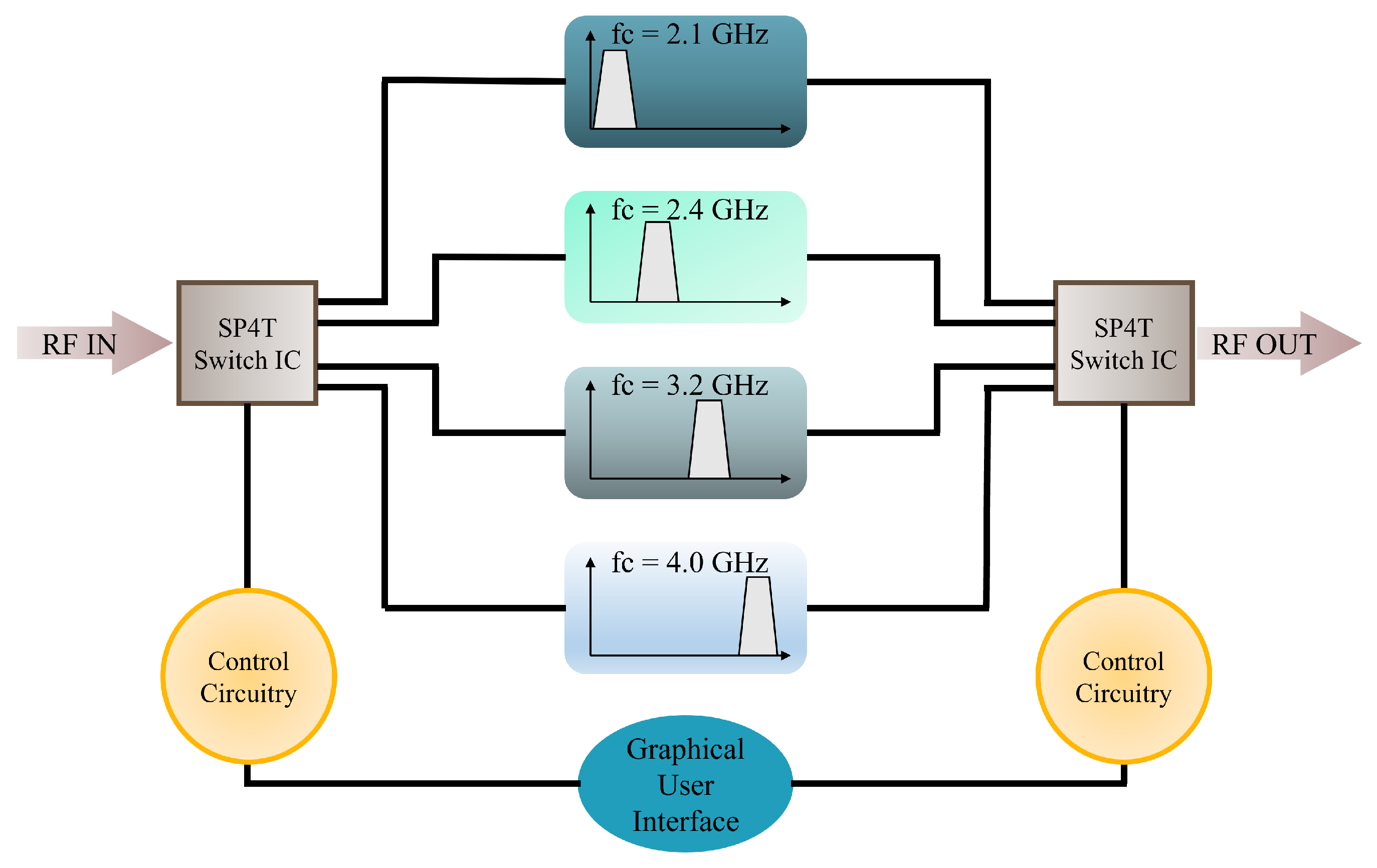


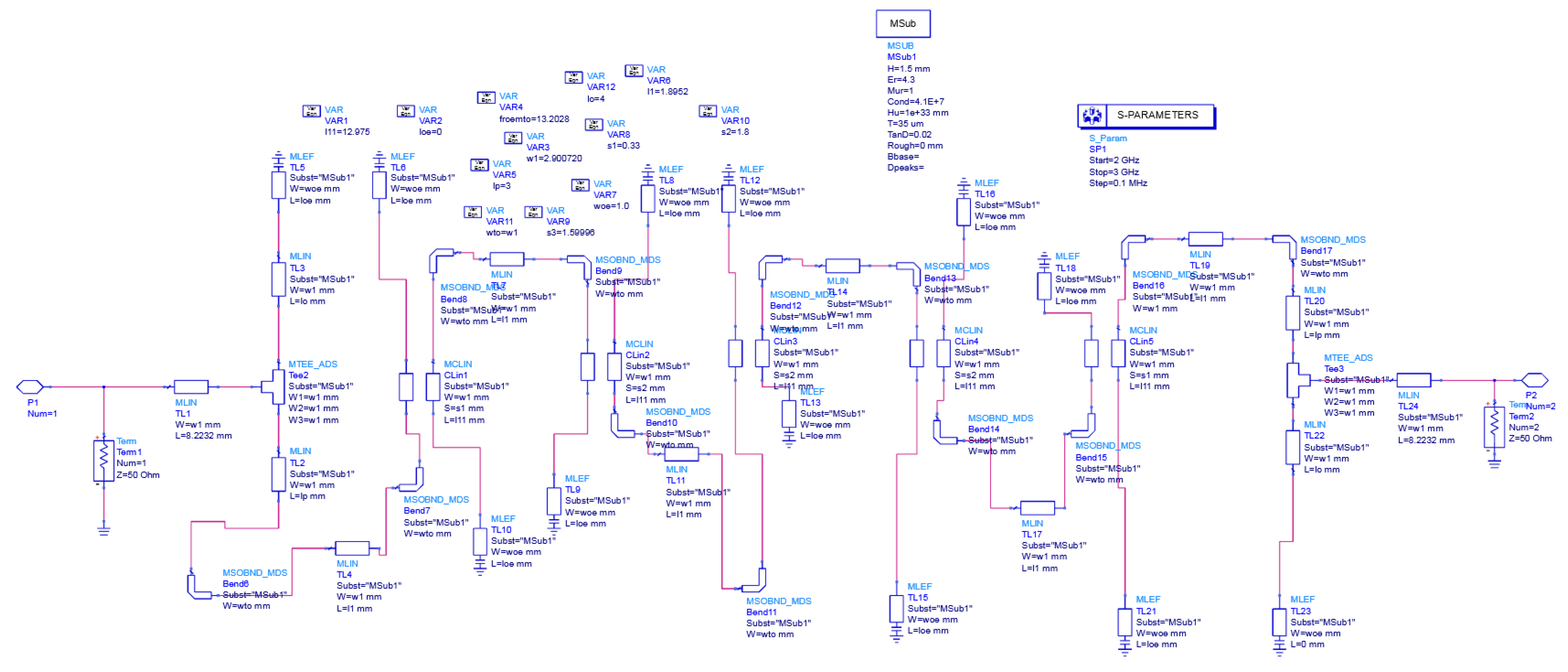

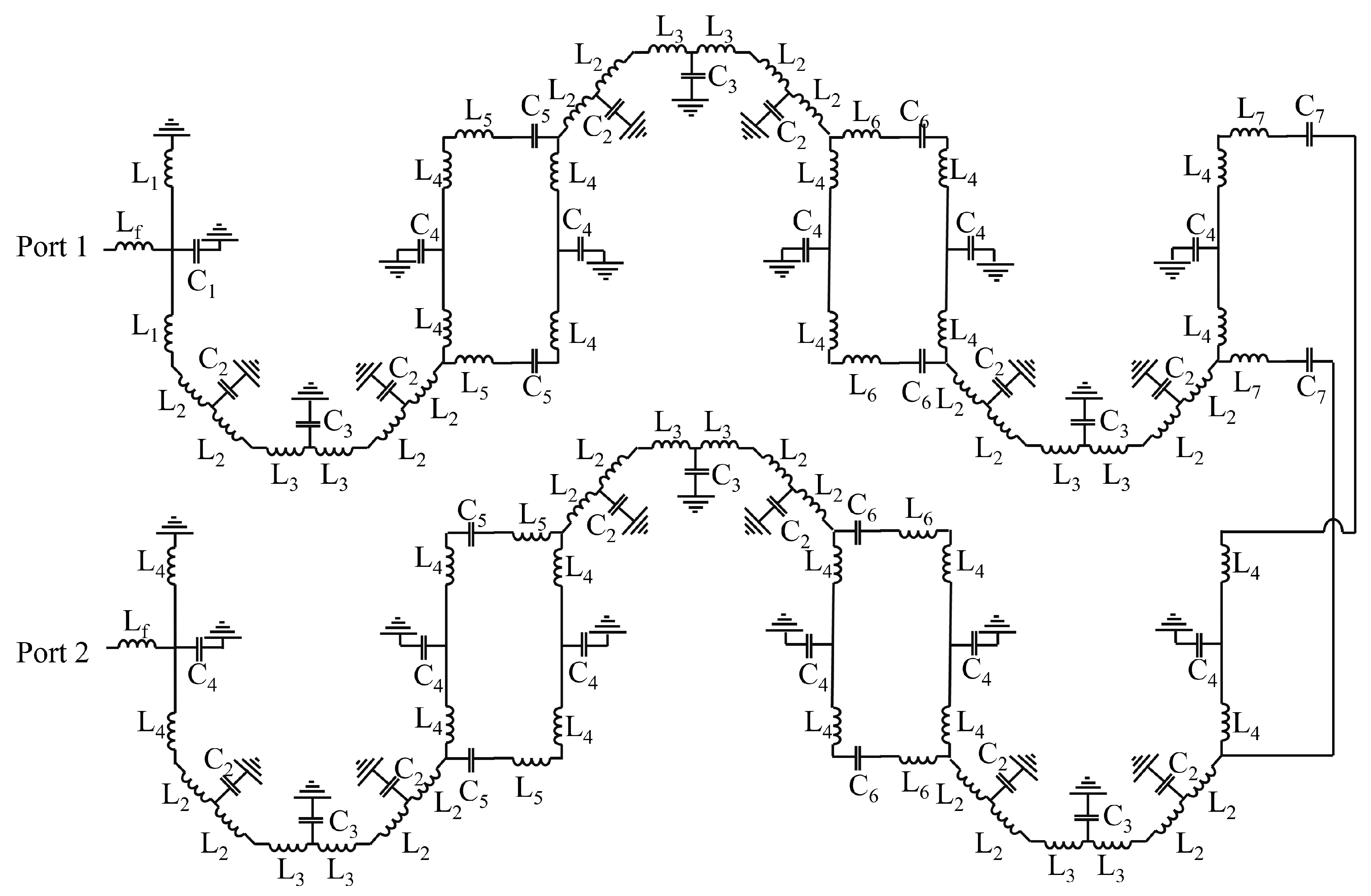
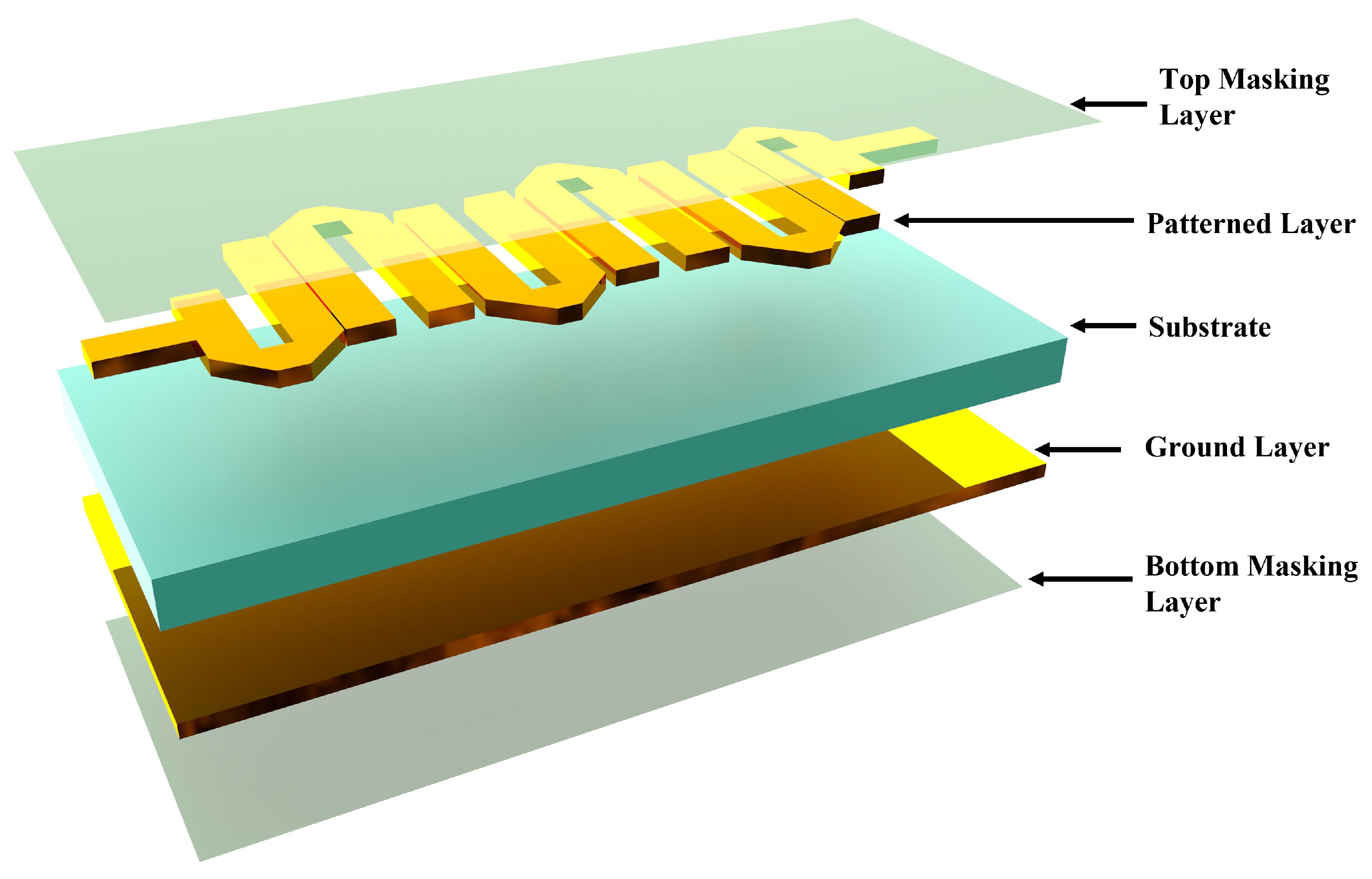
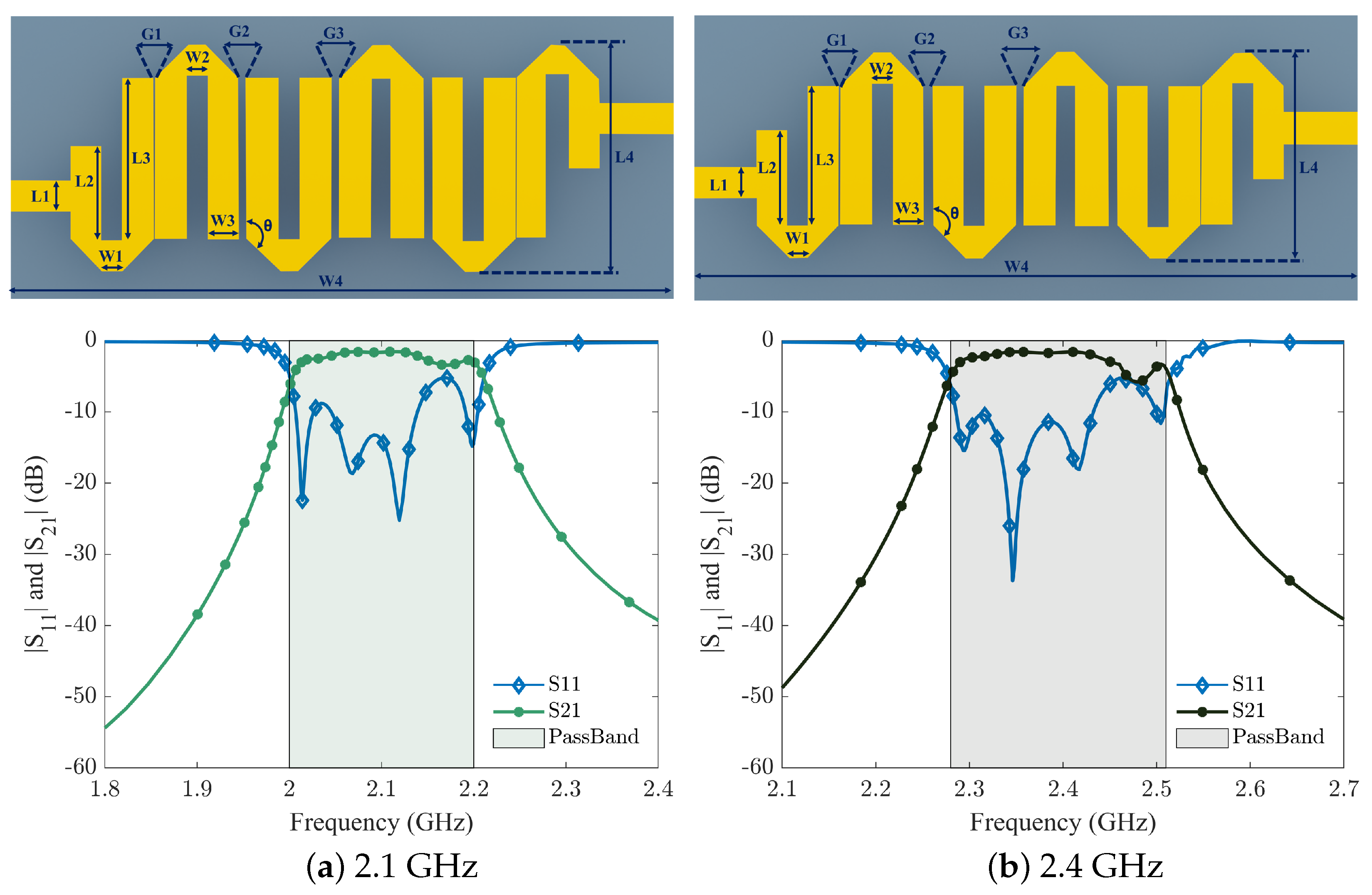

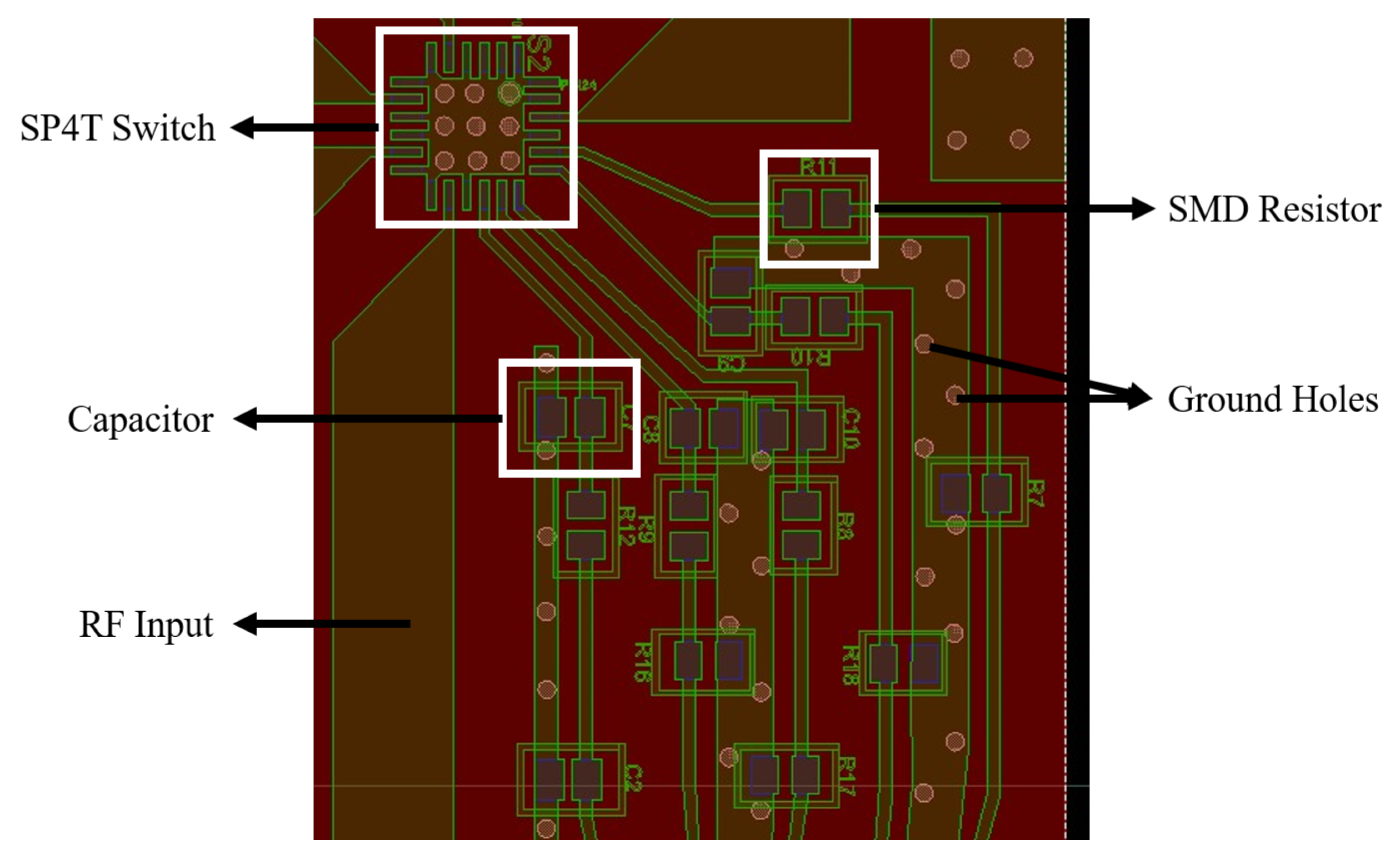

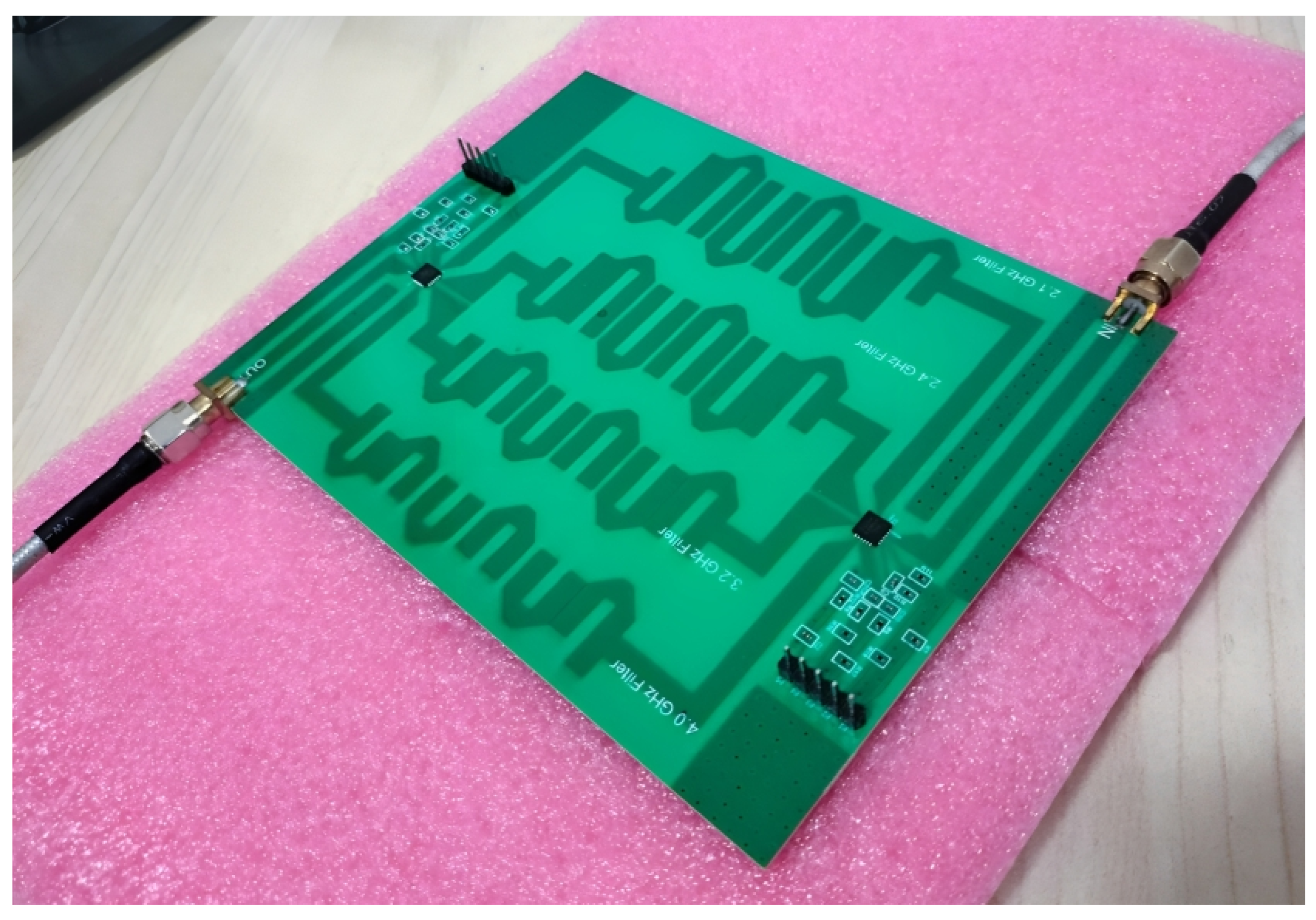
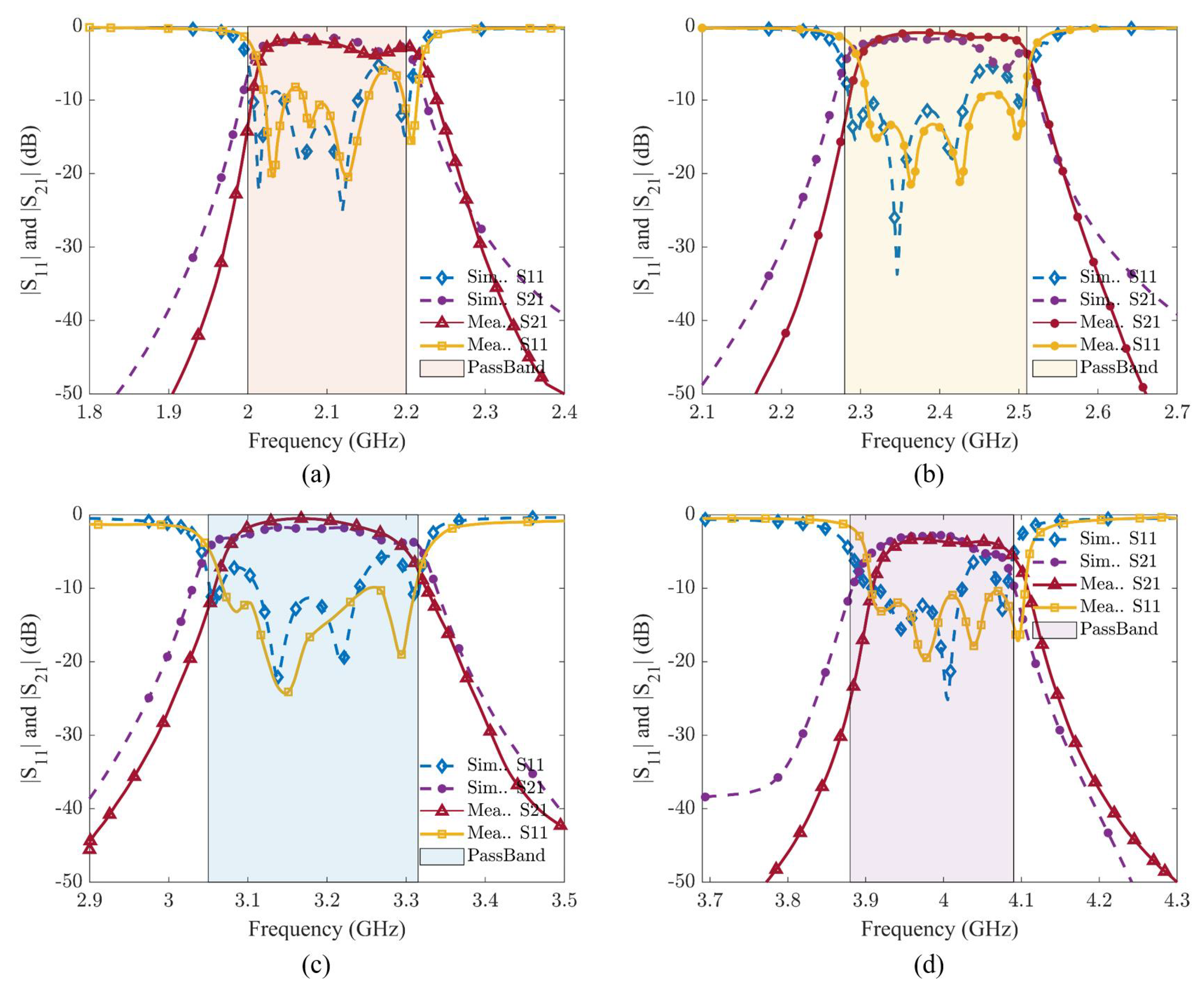
| BPF 1 | BPF 2 | BPF 3 | BPF 4 | |
|---|---|---|---|---|
| Centre Frequency | 2.1 GHz | 2.4 GHz | 3.2 GHz | 4.0 GHz |
| 1.33 nH | 1.33 nH | 1.33 nH | 1.33 nH | |
| 0.70 nH | 0.70 nH | 0.70 nH | 0.70 nH | |
| 0.48 nH | 0.48 nH | 0.48 nH | 0.48 nH | |
| 0.12 nH | 0.12 nH | 0.12 nH | 0.12 nH | |
| 1.20 nH | 1.02 nH | 0.69 nH | 0.50 nH | |
| 2.72 pF | 2.72 pF | 2.72 pF | 2.72 pF | |
| 0.94 pF | 0.94 pF | 0.94 pF | 0.94 pF | |
| 0.47 pF | 0.47 pF | 0.47 pF | 0.47 pF | |
| 4.61 pF | 3.93 pF | 2.68 pF | 1.94 pF |
| SP4T Switch Specifications | Substrate Specifications | ||
|---|---|---|---|
| Switch Model | HSWA4-63DR+ | Substrate | Rogers’ RO4350b |
| Isolation (0.9 GHz) | 61 dB | Dielectric Constant | 3.48 |
| Insertion Loss (0.9 GHz) | 0.9 dB | Substrate Thickness | 0.508 mm (20 mils) |
| Switching Speed | 255 ns | Loss Tangent | 0.0037 |
| Rise Time | 100 ns | Metal Thickness | 0.035 mm |
| Fall Time | 100 ns | - | - |
| Operating Temperature | −40 °C to 105 °C | - | - |
| RF Power Input | 34 dBm | - | - |
| BPF 1 | BPF 2 | BPF 3 | BPF 4 | |
|---|---|---|---|---|
| Centre Frequency (GHz) | 2.1 | 2.4 | 3.2 | 4.0 |
| L1 | 3.41 | 3.41 | 3.41 | 3.41 |
| L2 | 10.77 | 10.76 | 10.77 | 10.77 |
| L3 | 18.23 | 15.88 | 10.96 | 7.67 |
| L4 | 25.77 | 23.07 | 18.16 | 15.23 |
| W1 | 1.89 | 1.89 | 1.89 | 1.89 |
| W2 | 2.59 | 2.59 | 2.59 | 2.59 |
| W3 | 3.41 | 3.41 | 3.42 | 3.42 |
| W4 | 60.31 | 60.39 | 60.56 | 62.66 |
| G1 | 0.14 | 0.15 | 0.14 | 0.10 |
| G2 | 1.15 | 1.17 | 1.20 | 1.85 |
| G3 | 1.15 | 1.16 | 1.19 | 1.85 |
| 135° | 135° | 135° | 135° |
| Components | Value |
|---|---|
| C2 | 1 uF |
| C7, C8, C9, C10 | 100 pF |
| R7, R8, R9, R10, R11, R12 | 0 M |
| R16, R17, R18 | 1 M |
| S2 | HSWA4-63DR+ |
| References | [45] | [46] | [47] | [48] | [22] | [49] | [50] | Current Work |
|---|---|---|---|---|---|---|---|---|
| Centre Frequencies (GHz) | 0.4–3.0 | UWB 2.4 | 4.5 | 14.25 16.25 | 0.040, 0.0675, 0.1135, 0.189, 0.315, 0.453 | 2.335, 2.425, 2.550 | 0.600, 0.685, 0.770, 0.850 | 2.1, 2.4, 3.2, 4.0 |
| Insertion Loss | 3.2–6.8 dB | 1.9–2.1 dB | 0.8 dB (simulated) | 2 dB | 0.1 dB (simulated) | 4–6 dB | 3.5–4 dB | 1.2–3.0 dB |
| Return Loss | 12–38 dB | 18 dB | 20 dB | 15 dB | 16 dB | 11–16 dB | 25 dB | 15–25 dB |
| Relative Bandwidth | 450 | 400 | 5.2% | 500 MHz | 20–158 MHz | 6–8.5% | 11–16% | 200 MHz |
| Size ( × ) | 0.034 × 0.048 | 0.049 × 0.049 | NA | NA | NA | 0.763 × 0.389 | 0.500 × 0.290 | 0.903 × 0.693 |
| Topology | Nested Filters | Half-wave and quarter-wave resonators | Hairpin | Waveguide | Lumped Element | Hairpin Comb | Hairpin | Hairpin |
| Switching Technique | MEMS Switches | PIN diode | MEMS Switches | MEMS Switches | Not selected (no hardware) | Serial Switched | MMIC | Solid-State Switches |
| Channels | 2 | 2 | 2 | 2 | 6 | 3 | 4 | 4 |
Disclaimer/Publisher’s Note: The statements, opinions and data contained in all publications are solely those of the individual author(s) and contributor(s) and not of MDPI and/or the editor(s). MDPI and/or the editor(s) disclaim responsibility for any injury to people or property resulting from any ideas, methods, instructions or products referred to in the content. |
© 2024 by the authors. Licensee MDPI, Basel, Switzerland. This article is an open access article distributed under the terms and conditions of the Creative Commons Attribution (CC BY) license (https://creativecommons.org/licenses/by/4.0/).
Share and Cite
Alvi, T.S.; Ahsan, M.H.; Ali, M.; Ramzan, F.; Aljaloud, K.A.; Alqahtani, A.H.; Hussain, R.; Alomainy, A.; Mehmood, M.Q. A High-Performance, Low-Cost, and Integrated Hairpin Topology RF Switched Filter Bank for Radar Applications. Sensors 2024, 24, 434. https://doi.org/10.3390/s24020434
Alvi TS, Ahsan MH, Ali M, Ramzan F, Aljaloud KA, Alqahtani AH, Hussain R, Alomainy A, Mehmood MQ. A High-Performance, Low-Cost, and Integrated Hairpin Topology RF Switched Filter Bank for Radar Applications. Sensors. 2024; 24(2):434. https://doi.org/10.3390/s24020434
Chicago/Turabian StyleAlvi, Talha Shahid, Muhammad Haris Ahsan, Muhammad Ali, Faizan Ramzan, Khaled A. Aljaloud, Ali H. Alqahtani, Rifaqat Hussain, Akram Alomainy, and Muhammad Qasim Mehmood. 2024. "A High-Performance, Low-Cost, and Integrated Hairpin Topology RF Switched Filter Bank for Radar Applications" Sensors 24, no. 2: 434. https://doi.org/10.3390/s24020434
APA StyleAlvi, T. S., Ahsan, M. H., Ali, M., Ramzan, F., Aljaloud, K. A., Alqahtani, A. H., Hussain, R., Alomainy, A., & Mehmood, M. Q. (2024). A High-Performance, Low-Cost, and Integrated Hairpin Topology RF Switched Filter Bank for Radar Applications. Sensors, 24(2), 434. https://doi.org/10.3390/s24020434






